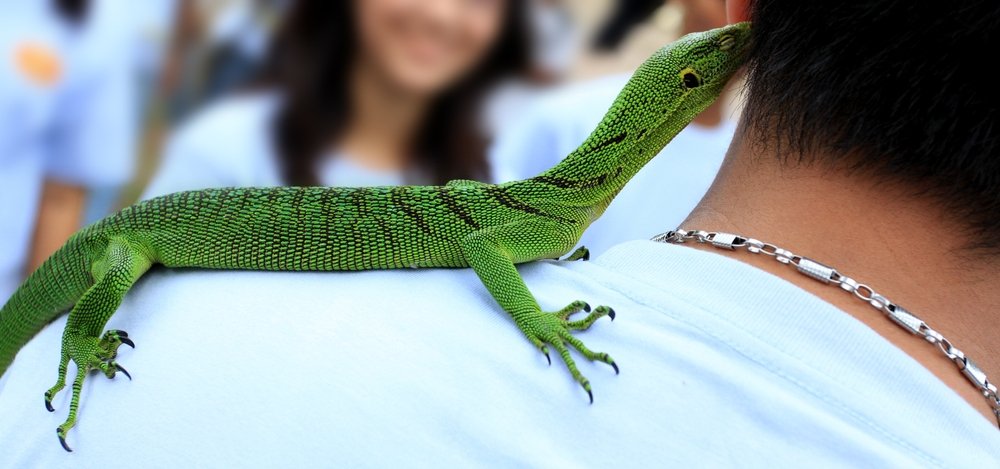The natural history and captive husbandry of tree monitors
Varanids, monitor lizards or ‘goannas’ are some of the most interesting reptiles on the planet. Members of this family of lizards can be found throughout Africa, Asia and Oceania. From three-meter long Komodo dragons (Varanus komodoensis) to 25cm short-tailed monitors (V. brevicauda), morphologically, this is one of the most diverse genera on the planet. They inhabit a range of environments from the canopies of tropical rainforests to underground burrows in dry deserts. Despite these vastly different characteristics, they are united by their incredible cognitive ability, superhero senses and prehistoric natural history.
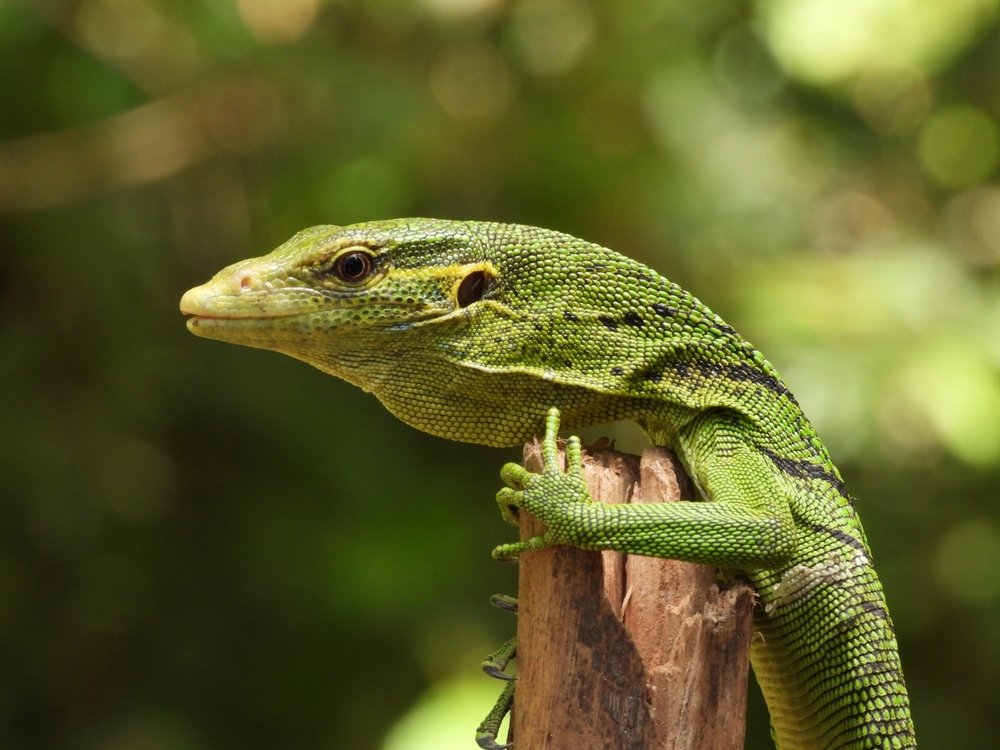
Varanidae
Over half of all 80+ species of Varanid (comprised of the genera Varanus and Odatria) are found in Australia, making Oceania a hotspot for this genus. Not only are the large landmasses of Australia and New Guinea brimming with monitor lizards, but the fragmented islands across the wider region have fuelled incredible speciation. North of Timor-Leste lies “Wallacea”, a zoogeographical area comprised of many islands between Borneo and New Guinea, which provides a haven to a whole spectrum of unique monitor lizards. This region of the Pacific produces some startlingly unique taxa and is generally considered the location where Alfred Wallace first described the theory of evolution (which Darwin would later build upon in the Galapagos). Here, the reptiles exhibit stunning colouration from the blue vipers (Cryptelytrops insularis) of Komodo, to the ‘biak’ green tree pythons (Morelia azurea) of Papua, each species has evolved distinct ‘locale’ forms and in many cases, entirely different species.
There are currently around eight species belonging to the Emerald tree monitor (V. prasinus) species group. This ‘complex’ was formed to describe a group of different species which researchers previously thought were subspecies of the emerald tree monitor. One example, the ‘mysterious’ tree monitor (V. telenestes) has never been seen alive. A holotype of this animal discovered on the island of Rossel has had scientists scratching their heads since 1991. The yellow tree monitor (V. reisengeri) is also data deficient in almost all research and is only found on the remote island of Misool. Other species, such as the canopy monitor (V. keithhornei) are common and frequently studied in their home range of North Australia. All tree monitors vary in their morphology but are generally slim-bodied, medium-sized lizards that live at low elevations across dense woodlands, tropical forests and in some cases, plantations. Of these species, only three are being regularly bred in captivity (with V. reisengeri receiving more attention in recent years) and frequently exhibited in zoos. These are the emerald, black and blue-spotted tree monitors.

Emerald tree monitor
(Varanus prasinus)
The emerald or green tree monitor is widespread through lowland tropical rainforests and mangroves across New Guinea and the Torres Strait Islands. Unconfirmed sightings (most recently in 2017) suggest that this species might also be present in the Cape York Peninsula in Far North Queensland, Australia. They have the largest distribution of all tree monitors, which explains why for decades, V. prasinus was thought to be the only tree monitor species. V. prasinus is also extremely variable in colour considering its distinct common name. Animals can range in hues of green, yellow and turquoise with unique patterns across their entire body.
They are one of the smaller tree monitors, reaching up to 80cm. Much of this length is comprised of a prehensile tail, a trait unique to tree monitors which facilitates their highly arboreal life. In fact, of all the Prasinus complex, few rarely venture to the forest floor. They are primarily insectivorous but will opportunistically feed on eggs, chicks and small rodents and have been observed smashing small vertebrates and snails against hard surfaces before devouring them.
Adam Radovanovic is a keeper at Birmingham Wildlife and Conservation Park and has been working with tree monitors for six years. He told Exotics Keeper Magazine: “Generally, I have found tree monitors to be very intelligent. I think their high activity levels play into this more than V.albigularis, for example. I’m sure this species has the same intellectual/learning capabilities as the tree monitor complex, but it’s not always so visible.”
“To provide mental enrichment we interact a lot with our prasinus. He came to us from another zoo and was already nearly a year old at the time and wasn’t handled much, making him quite skittish. We had our black tree monitors from hatchlings and they were fantastic as I could let them sit on my shoulder and handled them on a regular basis. I wouldn’t go in to pick them up, I’d just offer them my hand and they’d walk on to me, up my arm onto my shoulder. We also use sections of hollow bamboo with various sized holes in (being careful that the lizards can’t get their heads stuck) and use them as a feeder by putting crickets, locust, pachnoda etc in there. It’s amazing how much time they spend trying to grab out invertebrates with their hands. We also use deeper substrates with lots of dried bamboo so any that escape can hide amongst the floor and you see the lizards wandering around foraging sticking their nose into the substrate. We often change up the exhibit so it’s “different” with branching, adding different leaves to the bottom of the enclosure etc. Sensory enrichment is very important not only for tree monitors but for all varanids due to their acute sense of smell.”
Although several tree monitors have been kept by hobbyists for decades now, they have always been regarded as a very specialised species that requires expert knowledge to maintain. Previously, they were widely considered a fragile species but are now kept successfully in many zoos. Adam continued: “I don’t think V.prasinus or even V.beccarii (only two I’ve worked with) are fragile species and captive individuals do very well on display and demonstrate natural behaviours in front of the public. However, it is important to use the available space properly. You can really maximise the space of an enclosure and make it heavily complex for the individual(s) by using lots of branches and cork bark hides/tubes at all different levels which allows multiple platforms for basking/uptake of UVB at different parameters etc.”
Varanids have been maintained in captivity since the 1800s, with Alfred ‘Gogga’ Brown pioneering their husbandry following his publications dating back to 1834. However, the first official captive breeding of a Varanus species did not happen until 1941 when a Komodo dragon (V. komodoensis) produced surprise offspring, having dug her nest, laid her eggs and incubated the clutch completely unbeknown to keepers. Over that time, husbandry methods have improved but it is only very recently that successful clutches are being produced. In fact, reproductive failure is widespread across many monitor lizards.
Keepers are becoming more and more successful with just about every Varanid species in captivity. Yet, there is still a lot to learn despite more captive-bred animals being produced by zoos and private breeders. “Varanus prasinus is part of an ESB (European studbook) but it’s not too active at the moment, mainly due to so few females around” explained Adam. “Some collections have been exceptional with breeding prasinus but that has over-represented certain genetics. The breeding of this species still hasn’t been fully explored or understood and more breeding attempts are needed to really map out this species and have a better understanding of not only breeding parameters but also environmental parameters, nutrition and overall husbandry which plays a huge part in conditioning for these animals.”
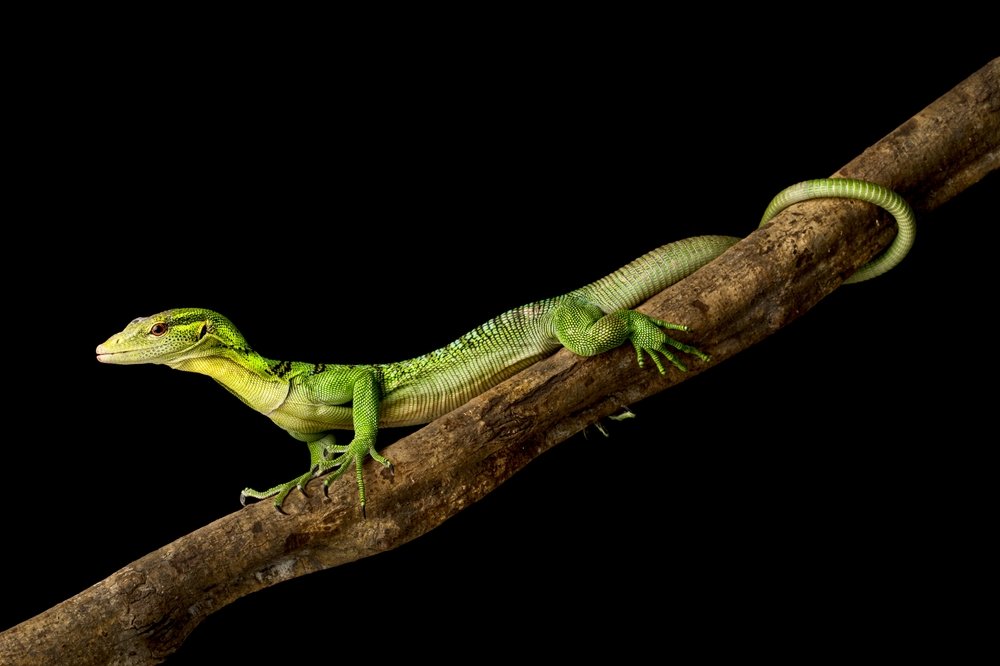
Black (Beccari’s) Tree Monitor
(Varanus beccarii)
Jamie Gilks is Head of Reptiles at Crocodiles of the World. The Zoo, which (unsurprisingly) specialises in large reptiles has been breeding black tree monitors (Varanus beccarii) for three years. He told Exotics Keeper Magazine: “Black tree monitors are of the subgenus Hapturosaurus, which quite fittingly translates to “grasp tail lizards”. This subgenus is also largely referred to as the V.prasinus complex. Black tree monitors were first described in the late 1800s and are endemic to the Aru Islands of Indonesia. The Aru Island Regency is made up of around 95 low-lying islands. These islands have central habitats that largely consist of moist lowland rainforest, whereas coastal areas of the islands have mangrove forests. Unfortunately, a majority of the black tree monitors’ suitable habitat has already been lost.”
The black tree monitor is one of the larger tree monitors, with adults reaching around 120cm in length. Males are generally slightly bigger than females but both display an entirely black colouration. Currently, the IUCN lists this species as ‘Data Deficient’ meaning that despite clear threats of deforestation across Aru, there is more to learn about the conservation status of the species. As such, captive breeding is considered an important part of conservation. Although there are a handful of zoos and private hobbyists that have been successful with green tree monitors and more recently, blue-spotted tree monitors, black tree monitors are still reasonably uncommon in a captive setting. Jamie continued: “I would say most of our visitors haven’t heard of a black tree monitor before visiting, so just raising general awareness about the species (although very basic) is a great start. Being such an active and outgoing species, they have proven to be a great conversation starter with our visitors and receive a huge amount of dwell time. This really allows us to speak in detail about some of the threats they face such as fragmentation, collection for the international pet trade and threats from development and agricultural industries. As little is known about the wild populations it’s difficult to know exactly what damage is being caused by international trade. Gaining more experience and knowledge in the care and breeding of this species as a community will be hugely important and will hopefully help reduce a bit of pressure from wild collection in the future.”
Monitor species are widely regarded as the most intelligent reptiles on earth and require constant mental stimulation. Studies at San Diego Zoo discovered that some are even capable of counting. Keepers would provide a set number of snails each day and on occasion provide slightly less. This prompted the lizards to continue searching for the missing snails. It is also widely understood that monitor lizards will recognise their keepers and build a specific bond with an individual person. Add to this that tree monitors are both arboreal and have extremely dextrous appendages and the opportunities and necessity for good enrichment are huge.
Jamie continued: “Feed-based enrichment is probably our most frequently used method, but we try to change the way this is presented as often as we can to avoid the animals getting overly familiar with particular enrichment feeders. Of course, it’s not all food-related. We’ve found that frequent and seasonal décor changes such as thin twisted willow branches work well for getting the monitors to shift their weight and use their tails a bit more whilst climbing. I’d also like to work a bit more with vines and swinging branches to help improve muscle tone. I think any of these examples could be used or adapted by private keepers to suit their set up and species, I would just make sure you know where your materials have come from, and that they are safe and suitable for the animal.”
Since maintaining the species, keepers at Crocodiles of the World have made some very interesting observations. Jamie continued: “When we moved a group of forktail rainbow fish into the exhibit we began to find our female sitting under a cork piece that hung over the water’s edge, she would sit there from evening to late morning and this pattern continued for a couple of weeks before stopping. In hindsight, it would have been nice to make a few more observations later in the evenings and earlier in the mornings to see if she was just resting there coincidentally at the same time fish were introduced, or if she was attempting to catch the fish at first and last light. Also, It may just be the animals we house but our V.beccarii are seemingly more confident and inquisitive than our V.prasinus. Unfortunately, I haven’t had the opportunity to work with other members of the complex to compare.”
Crocodiles of the World received international praise earlier this year for breeding the first Giant Galapagos tortoises (Chelonoidis niger) in a UK zoo. Whilst these charismatic chelonians may have caught the attention of the general public, there are a wealth of important breeding projects that the establishment is involved in, including one for the black tree monitor. Jamie continued: “Luckily, we haven’t had many issues with the general husbandry side of things. Our team are really good when it comes to researching and setting up for any new species coming into the collection. Paying close attention to seasonal parameters and dietary changes sounds obvious but if these aren’t correct the breeding project will always be on the back foot. The main challenge we’ve faced has probably been improving our incubation techniques. We lost our entire first clutch after about 70 days of incubation, since then we’ve made a few adjustments to temperature and increased airflow in the egg chambers and now we have close to a 90% success rate.”
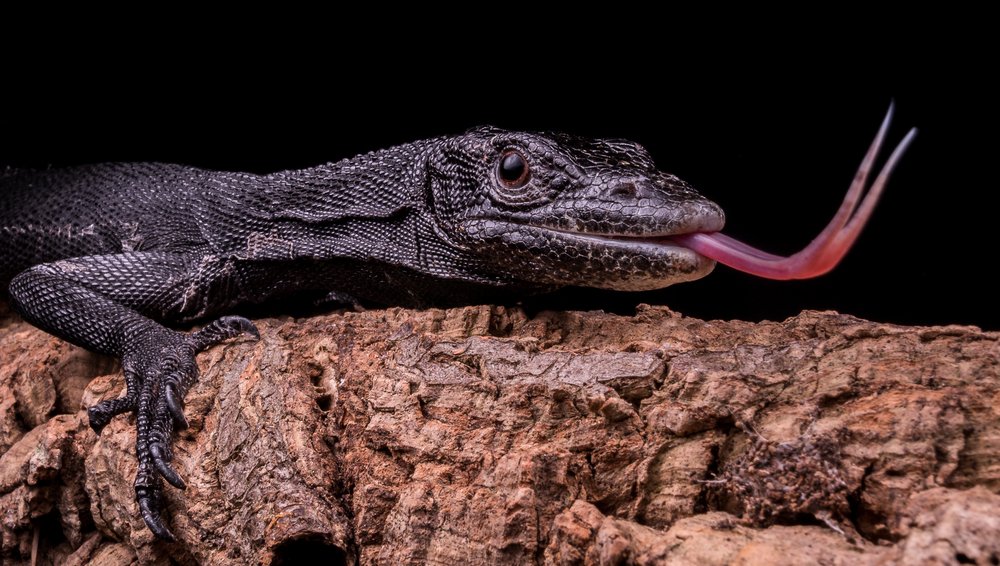
Blue-spotted tree monitor
(Varanus macraei)
The blue-spotted tree monitor is an arboreal species from the remote Indonesian island of Batanta, just off the coast of West Papua. The entire island is just 453km2. The fragility of this tiny island contributes to the species’ ‘endangered’ status. V. macraei was only discovered in 2001, by Duncan Macrae, founder of the Rimba Reptile Centre in Bali. Since its discovery, it was widely exported into the international pet trade. This demand was potentially very dangerous, as at the time we knew very little about the natural history of the species. Whilst we still continue to know very little about these highly localised species in the wild, concerted efforts from hobbyists and zoos are starting to turn that notion around.
Now, the species is frequently bred in captivity with zoos basing much of their breeding practices on research conducted by private hobbyists who had imported them in the previous decade. Bristol Zoo was the first UK establishment to successfully breed V. macraei in 2019 and several others quickly followed suit. Daniel Kane is a Senior Reptile Keeper who maintains the species at ZSL London Zoo. He told Exotics Keeper Magazine: “The exhibit we have is very large, as they’re such an active species. 2.5 x 2.5 x 2.5 meters. If you look at the palms of their hands and the soles of their feet, they have these hard rubbery scales that give them extra grip. They have long claws and a prehensile tail, but those specialised scales also give them extra grip. One of their trademark things is extractive foraging, so we ensure our cork tubes have holes to stick their hands and noses in. They also do this with tree bark, so they’ll stick their noses under the bark and if they can’t quite get their full head inside, they’ll open their mouth to lift the bark up, then reach their hand in there. We also have ledges up high so she can be completely out of view of visitors if she wishes.”
“They do seem to require stimulation and prasinus are no different. When we started putting in lots of bigger live plants, you’d see them shredding the leaves up. As a keeper we think, c’mon, don’t do that. But, the more we observed, the more we identified a pattern. What this particular lizard would be doing is shredding a leaf off and holding it with her front feet to tear it up. Or, she would take it up to the highest ledge in the exhibit, drop it and race it down to the bottom to try and catch it. We ran this behaviour through play criteria and together with Bristol Zoo, we have written a paper on play behaviour in tree monitors. We can now definitively say tree monitors in zoos and other collections do play!”
As such closely related species, the tree monitors often have similar traits and behaviours. It is only when working with many individuals of two or more species that herpetoculturists can begin to theorise behavioural differences in captivity. However, anecdotes can certainly identify potential differences to explore. Dan continued: “In terms of individuals, this macraei can eat loads and not put on any weight. However, this prasinus, if she ate the same as the macraei, she’d be the size of the exhibit! We feed our macraei three times a week, varying types of prey. I would say it’s about 90% insectivorous, but they also get the odd quail egg. They also have a weird fondness for shellfish. I can’t imagine how much seafood they’re eating in the wild, but they absolutely love it here. They’ll have entire tiger prawns which takes them a while to get through. It’s not quite a carcass feed but having those bits that they must tear into simulates wild behaviours. Sometimes we’ll get stick insects too, like Eurycantha. They’re a Papuan species, so it’s nice to provide something they would naturally take out of the wild.”
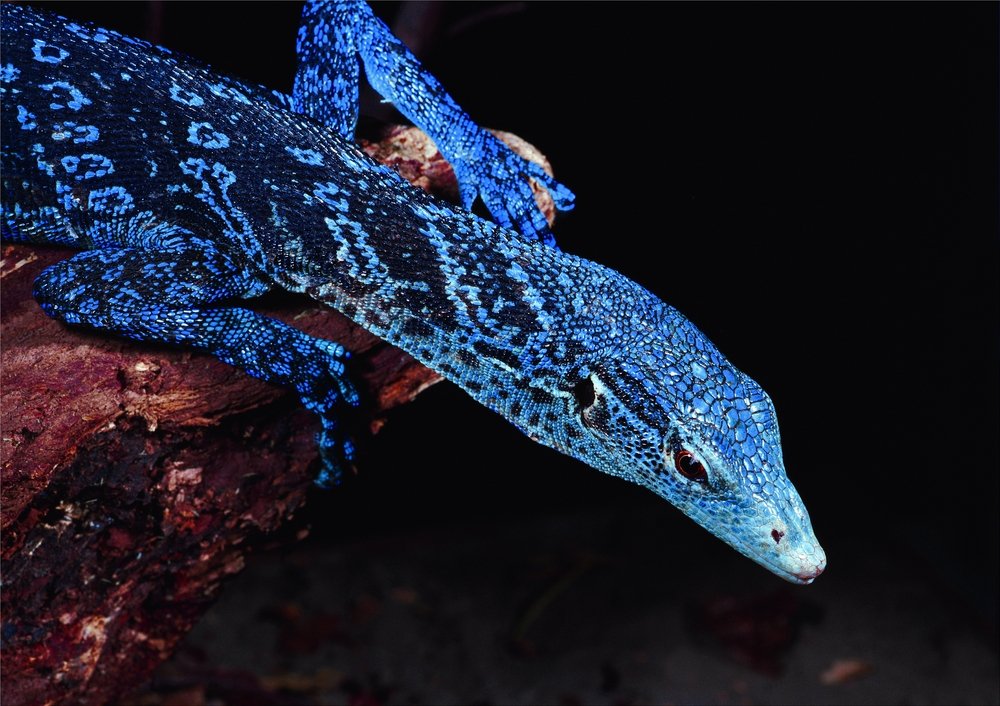
Enrichment for lizards
Although monitor lizards are famed for their problem solving and high cognitive ability, enrichment is important for all captive animals. Not all species will respond in the same way, but even novice reptile keepers can implement strategies to exercise their animal’s minds and improve captive welfare.
A recent paper published by researchers at Chester Zoo analysed enrichment methods of three Southeast Asian Varanids. These were the terrestrial Komodo Dragon of Indonesia and the arboreal green tree monitor and crocodile monitor (Varanus salvadorii) of New Guinea. It states: “There are five main ways in which environmental enrichment may be provided: by (1) creating and managing a dynamic habitat, (2) encouraging social interactions between individuals, (3) encouraging foraging, (4) introducing novel objects and (5) training. These methods aim to increase behavioural diversity, reduce abnormal behaviours, increase the range of natural behaviours demonstrated, increase the positive use of the environment, and increase the animal’s ability to cope with challenges in a more natural way.”
The researchers published many observations of enrichment techniques that typically contrast our general understanding of enrichment methods for reptiles. For example: “The provision of food- versus scent-based enrichment did not result in differences in enrichment engagement across the three species, suggesting that scent is just as effective in increasing natural behaviours.” Scent trails are widely used as enrichment strategies for snake species. Experienced keepers of all snake species should be using scent trails within the enclosure. Those that handle their animals can create elaborate play areas outside of the vivarium and include scent trails too. Whilst most lizard species will rely much more on visual cues for hunting, introducing new smells, puzzle boxes, gradual feeding methods, etc could be beneficial. The paper continues: “Lizards exhibited significant increases in exploratory behaviour in response to hanging feeders, scent piles and scent trails. Contrary to our predictions, we found that engagement with these different enrichment types diminished more or less equally over time.” This period averaged out at around two and a half hours for each method of enrichment.
“Our results confirm that the most effective enrichment types may be those that mimic natural challenges routinely faced by lizards in the wild.”
